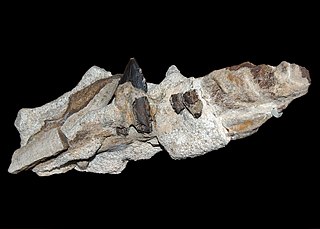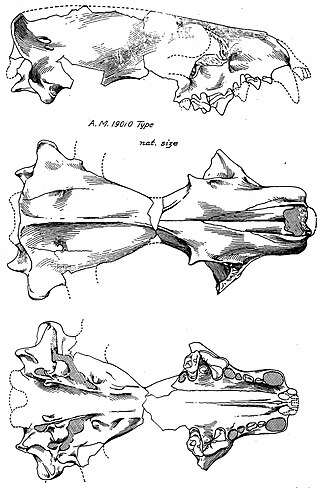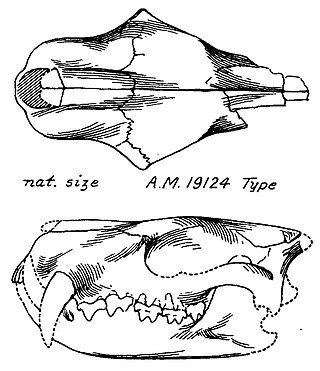
Miacis is an extinct genus of placental mammals from clade Carnivoraformes, that lived in North America from early to middle Eocene.

Miocyon is an extinct genus of placental mammals from clade Carnivoraformes, that lived in North America from early to late Eocene.
Brachyhyops is an extinct genus of entelodont artiodactyl mammal that lived during the Eocene Epoch of western North America and southeastern Asia. The first fossil remains of Brachyhyops are recorded from the late Eocene deposits of Beaver Divide in central Wyoming and discovered by paleontology crews from the Carnegie Museum of Natural History during the early 20th century. The type species, Brachyhyops wyomingensis, is based on a single skull and was named by E.H. Colbert in 1937, but was not officially described until 1938. During the latter half of the 20th century, additional specimens from North America have been recorded from Saskatchewan and as far south as Texas, indicating that Brachyhyops had a broad distribution and was well-dispersed throughout western North America.

Epoicotheriidae is an extinct paraphyletic family of insectivorous placental mammals within extinct order Palaeanodonta, that lived in North America, Asia and Europe from the late Paleocene to early Oligocene. Epoicotheriids were fossorial mammals. Late Eocene/early Oligocene genera were highly specialized animals that were convergent with the talpids, golden moles and marsupial mole in the structure of their skulls and forelimbs, and would have had a similar lifestyle as subterranean burrowers.

Asiavorator is an extinct genus of civet-like carnivoran belonging in the family Stenoplesictidae. It was endemic to Asia and lived during the Eocene and Oligocene epochs.

Palaeogale is an extinct genus of carnivorous mammal known from the Late Eocene, Oligocene, and Early Miocene of North America, Europe, and Eastern Asia. A small carnivore often associated with the mustelids, Palaeogale might have been similar to living genets, civets, and linsangs.

Patriocetus is an extinct genus of toothed whale.
The Astoria Formation is a geologic formation in Washington state & Oregon. It preserves fossils dating back to the early to middle Miocene.

Palaeanodonta is an extinct clade of stem-pangolins. They were insectivorous (myrmecophagous), possibly fossorial, and lived from the middle Paleocene to early Oligocene in North America, Europe and Asia. While the taxonomic grouping of Palaeanodonta has been debated, it is widely thought that they are a sister group to pangolins.

Crenatosiren is an extinct genus of dugongid sirenian known from the late Oligocene (Chattian) of Florida, North Carolina, and South Carolina. The type and only known species is Crenatosiren olseni.
Spalacotherium is a genus of extinct mammal from the Early Cretaceous of Europe. The type species Spalacotherium tricuspidens was originally named by Richard Owen in 1854, and its material includes maxillary and dentary fragments and many teeth from the Berriasian Lulworth Formation of southern England. Referred species include S. taylori, S. evansae and S. hookeri also from the Lulworth deposits, and S. henkeli from Barremian deposits of Galve, Spain. The Lulworth taxon Peralestes longirostris, named by Owen in 1871, is a junior synonym of the type species S. tricuspidens. Spalacotherium is the namesake taxon of the family Spalacotheriidae, which is an extinct clade within Trechnotheria that may be closely related to the Gondwanan clade Meridiolestida, or united with the family Zhangheotheriidae to form Symmetrodonta.S. evansae is also from the Berriasian aged Angeac-Charente bonebed in western France.

Xenocranium is an extinct monotypic genus of placental mammal from extinct paraphyletic subfamily Epoicotheriinae within extinct paraphyletic family Epoicotheriidae in extinct order Palaeanodonta, that lived in North America during the late Eocene.
Polymorphis is an extinct genus of litopterns belonging to the family Macraucheniidae. It lived during the Middle Eocene of Argentina.

Epoicotheriinae is an extinct paraphyletic subfamily of insectivorous placental mammals within extinct paraphyletic family Epoicotheriidae in extinct order Palaeanodonta, that lived in North America and Europe from the early Eocene to early Oligocene. Epoicotheriins were fossorial mammals. Late Eocene/early Oligocene genera were highly specialized animals that were convergent with the talpids, golden moles and marsupial mole in the structure of their skulls and forelimbs, and would have had a similar lifestyle as subterranean burrowers.
Protobradys is an extinct genus of mammal of unknown affinities from the Early Eocene of Chubut Province, Argentina. It was described in 1902 by prolific Argentine paleontologist Florentino Ameghino on the basis of an isolated left maxilla and an erroneously referred tooth. Ameghino described the genus as the earliest known member of Pilosa (sloths), though this assessment has not been supported and later authors believe that it is a nomen vanum of uncertain affinities within Mammalia.
Cryptomanis is an extinct genus of pangolin from extinct family Patriomanidae. The genus is only known from the holotype specimen from middle Eocene deposits from Inner Mongolia, China. The holotype, AMNH 26140, was for years labeled as an unnamed pangolin in the fossil collection for decades. The remains comprise of an incomplete postcranial specimen, with nearly complete hind limbs, an incomplete pelvis, a complete lumbar series from an incomplete vertebral column, numerous fragmentary remains of rib and sternal bones, a fragmentary scapula, and partially preserved forelimbs. Based on the femural length Cryptomanis was comparable in size to the modern Sunda pangolin.

Amphicticeps is an extinct genus of small, weasel-like carnivoran mammal. It lived in Mongolia during the Oligocene. The genus was erected in 1924 for the species A. shackelfordi on the basis of a well-preserved skull. Historically, the systematic position of this genus has been problematic until more specimens were described decades later.
The Ergilin Dzo Formation, is a geologic formation in southeastern Mongolia. It preserves fossils of a wide variety of animals, which date back to the late Eocene epoch. The type fauna of the Ergilian Asian land mammal age is defined by the mammalian fossils of this formation.

Didymoconidae is an extinct family of eutherian mammals that first appeared during the Paleocene epoch and survived into the latest Oligocene epoch. Its classification has been the subject of controversy, and the family has been placed in various orders since it was erected in 1943, sometimes being placed in its own order Didymoconida.
Ergilictis is an extinct genus of mammal that lived during the late Eocene and early Oligocene epochs. It was endemic to Asia, and its fossils have been found in the Ergilin Dzo and Hsanda Gol formations of Mongolia. It belongs to the family Didymoconidae, which has uncertain taxonomic affinities.










